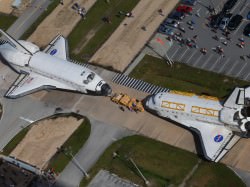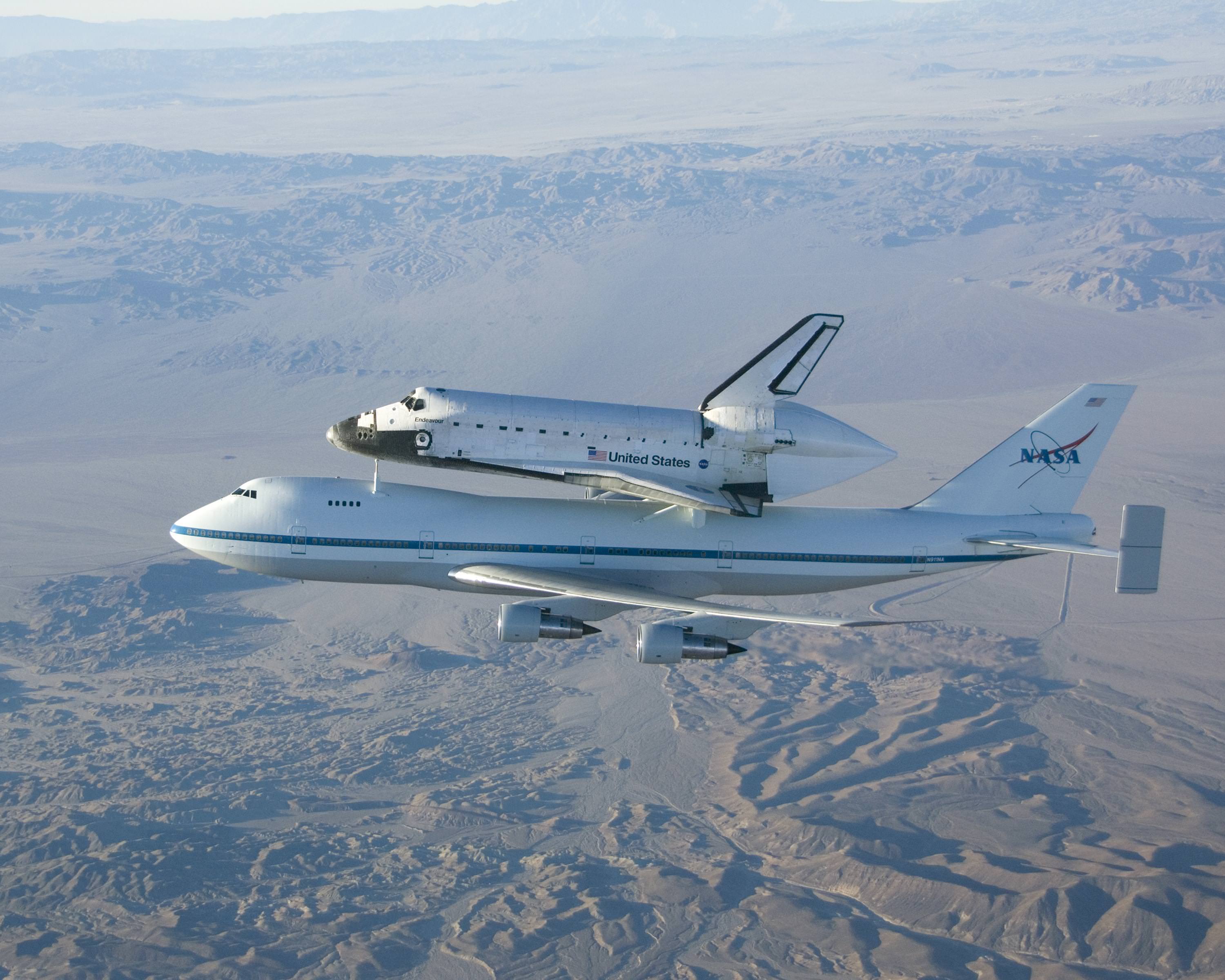One of NASA’s 747 SCAs carries Endeavour from Edwards to Kennedy in 2008 following its landing at Edwards to conclude shuttle mission STS-126. (NASA)
Endeavour, mounted atop NASA’s modified 747 Shuttle Carrier Aircraft (SCA), will become the last Space Shuttle orbiter to soar aloft when it departs Monday, Sept. 17, from Kennedy Space Center in Florida on a three-day flight to Los Angeles International Airport.
In cooperation with the Federal Aviation Administration, the SCA is scheduled to conduct low-level flyovers at about 1,500 feet above many locations along the planned flight path, including Cape Canaveral, Stennis Space Center, New Orleans and stopovers in both Houston and Edwards Air Force Base in California.
Read more about NASA’s SCA: “The World’s Greatest Piggy Back Ride”
 Flyovers of Sacramento and San Francisco are also planned before landing at LAX on the 20th.
Flyovers of Sacramento and San Francisco are also planned before landing at LAX on the 20th.
After arrival at LAX, Endeavour will be demated from the SCA and spend a few weeks at a United Airlines hangar undergoing preparations for transport and display. The orbiter then will travel through Inglewood and Los Angeles city streets on a 12-mile journey from the airport to the California Science Center, arriving on the evening of Oct. 13.
See a map of Endeavour’s planned route across LA here.
Beginning Oct. 30, the shuttle will be on permanent display in the science center’s Samuel Oschin Space Shuttle Endeavour Display Pavilion, beginning its new mission commemorating past achievements in human spaceflight and educating and inspiring future generations of explorers.
On August 16 Endeavour was moved from KSC’s Orbiter Processing Facility 2 to the Vehicle Assembly Building, where it’s being housed temporarily until its departure on the 17th. (Photo above at right; read more here.)
On May 16, 2011, Endeavour launched on its final mission, STS-134:
Completed in July 1990, Endeavour (OV-105) was the last shuttle orbiter to be constructed for NASA. Endeavour completed 25 missions, spent 299 days in orbit, and orbited Earth 4,671 times while traveling 122,883,151 miles.
On Twitter and along Endeavour’s route? NASA encourages people to share their shuttle sightings using the hashtags #spottheshuttle and #OV105, Endeavour’s orbiter vehicle designation.
Read more and find the full flight itinerary on the NASA news release.


As a fitting tribute to a lasting legacy of space exploration, Nasa should land one of the old orbiters on the moon. Also, in the case of global or solar system catastrophe, at least there would be a lifeboat available.
Huh? The Space Shuttles never went to the moon. Their boosters and engines were just enough to get them to low earth orbit. Even if the shuttle orbiter did get to the moon somehow, it probably couldn’t land there gently. They landed in earth’s atmosphere using their wings. No atmosphere = crash.
That doesn’t make sense in so many ways…
Yep. Even Ralph from the Simpsons would say it was “Unpossible”.
Even when you try to be as outrageous as possible, people still take you seriously…
surrrrre
The shuttle… gets a robust thumbs up for what it WAS able to accomplish! But sadly, a thumbs down for the unrealized promise of an inexpensive way to get to LEO. It cost around $! billion dollars for every launch! The term ‘boondoogle’ comes to mind here…. or pork? A bit of history? The original shuttle designs were for a MUCH more robust system. The booster stage was envisioned as a reusable giant hypersonic winged plane/launch platform.
http://history.nasa.gov/SP-4219/4219-283.jpg
http://www.google.com/search?q=Early+shuttle+configurations&hl=en&prmd=imvns&tbm=isch&tbo=u&source=univ&sa=X&ei=AlJKULW9LYzQigKn9oDoAQ&ved=0CE0QsAQ&biw=1056&bih=670
These concepts were dropped as the price for building those complex booster stages soared. Then President Richard Nixon put an end to the ‘dream’ of an inexpensive way to LEO when he urged NASA to ‘rethink’, then downsize the space shuttle plan. What we got in return was a much less capable and far less robust design. This design left the main tank unusable and discarded – to be incinerated upon re-entry. And one that used solid rocket boosters (Thanks also to the efforts of ATF and Sen. Orin Hatch) to enable orbital speeds.
The previously envisioned space plane booster could have been used for many other types of vehicle launches. It was not to be…. dzzzzzz
And also, I think it was irresponsible to not reuse the existing shuttle main tanks on orbit. Boosting them high enough to sustain orbit, then refitting them into usable habitat, similar to Sky Lab’s design, was NOT that ‘far out’ of an idea. Oh well.. live and learn.. tvist and turn!
The dividends of creating a hypersonic space plane/booster, would have paid for themselves, over time, considering the billion dollar a ‘pop’ shuttle flights… Short sighted economics are still en vogue… oui?
The background in the first picture looks like Mars. Just saying…
it’s going to make a stop in my hometown El Paso on Sept 16 Can’t wait to see her!!!